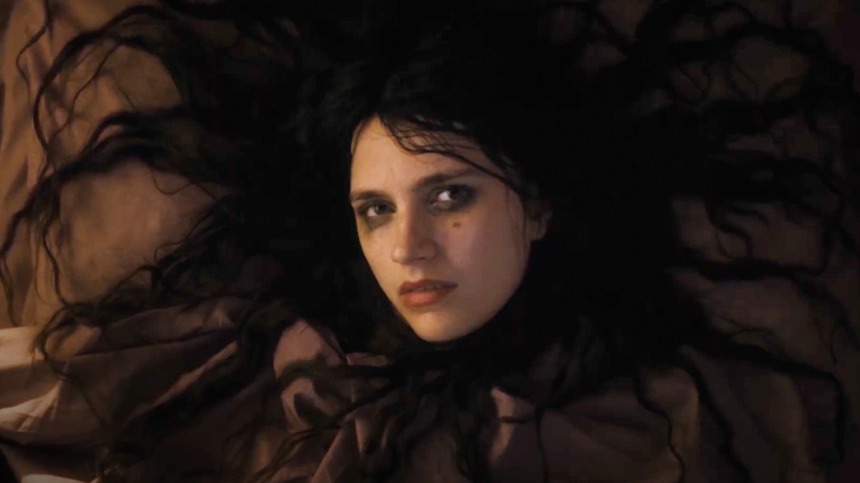THE FIRST OMEN Review: Religious Horror Undermined by Prequelitis

Just because IP (intellectual property) has gone dormant doesn’t mean it’s dead.
As long as there’s a rights-holder with profit on their individual and collective minds, the figurative and literal resurrection of a series or franchise remains an open, even likely, possibility at any time between now, the next century, and beyond. Not even the inevitable, inexorable passage of time — say, for example, 43 years since an original trilogy wrapped up a particular storyline or a remake failed to relaunch the series in question — can dim the hopes and dreams of executives with clear title to an IP, a subject (horror) usually favored by moviegoers, and a modest budget to match the expected ROI (return on investment).
All of which makes writer-director Arkasha Stevenson’s feature-length debut, The First Omen, the prequel to The Omen trilogy that began promisingly in 1976 and ended with a box-office whimper in 1981, something of a minor, albeit flawed, miracle, elevated by Stevenson’s crisp, unobtrusive direction, a doom-laden, mystery-centered screenplay, and a committed, unironic central performance by Nell Tiger Free as Margaret Daino, a new-to-Rome novitiate who stumbles into a sinister conspiracy involving a misguided Catholic splinter group, a diabolical plan to accelerate the end times as a means to combat the evils of secularism, and an unplanned pregnancy involving the Antichrist (unnamed here, later Damien).
Set in 1971, a time of social, political, and cultural unrest, The First Omen is positively awash in period flavor, including, but not limited to, the cross-decade clothes worn by everyday Italians, the Gothic-leaning production design, and almost as importantly, Italian rock-pop music to give The First Omen a giallo-adjacent feel. Between the visual elements and the narrative cues, augmented by Mark Koven’s brooding, foreboding score, The First Omen has all the elements to be a more than worthy addition to the Omen canon (however slight and repetitive it might be).
Stevenson drops a naive Margaret straight into Rome’s busy airport and into the comforting arms and smiling face of her longtime mentor, Cardinal Lawrence (Bill Nighy). Spotting a young, orphaned Margaret at a stateside orphanage almost two decades earlier, the good cardinal has overseen Margaret’s care and education, using his influence and authority to bring Margaret to Rome and the Italian convent where she’ll take holy orders and solidify her lifetime connection to the Roman Catholic Church.
Under the strict, authoritarian rule of Sister Silva (Sônia Braga), the convent also operates an orphanage. Almost immediately, Margaret becomes a part of the orphanage’s daily life, becoming a friend or teacher to the orphanage's wards while becoming increasingly concerned with the convent’s inability to adequately provide for the psychological and spiritual needs of young Carlita (Nicole Sorace), who suffers from debilitating hallucinations, flashes of hot temper, and bouts of furious drawing.
As a passive-reactive Margaret witnesses increasingly strange goings-on, including an explicit Caesarean birth of a young, unmarried woman conducted on orphanage grounds (a scene, like a latter one, bound to join the Cronenbergian Museum of Body Horrors), a defrocked priest, Father Brennan (Ralph Ineson), accosts Margaret in a Roman plaza, vaguely warning her of something or other horrible and attempting to enlist Margaret in his one-defrocked-priest’s crusade to uncover the convent/orphanage’s potentially nefarious deeds and, if possible, stop the Apocalypse before it has a chance to begin.
While Father Brennan serves a clear-cut narrative function, the character of the defrocked priest also ties The First Omen to The Omen. He’s the same priest who memorably expires in mid-sentence early in the 1976 film, the victim of an unholy, invisible intercessor.
At least here, Father Brennan gets both more screen time and more to do, eventually joining Margaret as she sheds her novitiate label and turns into an active, mystery-solving investigator. (Cue Margaret slipping surreptitiously into an underground vault to retrieve old birth records during the celebration of another novitiate taking holy orders.)
The mystery as such, however, isn’t a mystery, at least not in the usual sense. It’s a mystery with exactly one real or legitimate answer and that’s the answer The First Omen eventually embraces during the second half. Unsurprisingly, the narrative’s anti-mystery aspect negatively affects momentum — stopping it altogether on at least one or two occasions — but it’s the often clumsy, always noticeable groundwork connecting the prequel to the trilogy that all but scuttles the carefully built-up dread, tension, and suspense of the first half.
The First Omen uncannily mirrors the recent – as in three weeks old recent — Immaculate, another religiously-themed horror film centered around untrustworthy nuns, creepy convents, and the birthing of the Antichrist. More importantly, both share an overt willingness to explore issues of consent, bodily autonomy, and forced births, interrelated issues on the forefront of American voters, right or left, this coming November. Both films fall squarely on bodily autonomy without hesitation, reservation, or qualification.
Topicality, relevance, or urgency alone or collectively, of course, aren’t enough to elevate any film, regardless of its intent, into must-watch status or even watch-whenever-it-hits-streaming status, but it’s also hard to deny as a factor in favor of The First Omen. If only The First Omen had been a standalone horror film, unfettered by the limitations and demands of a half-century-old series, it might have belonged in the first category and not the second.
The First Omen is now playing, only in movie theaters, via 20th Century Studios.
The First Omen
Director(s)
- Arkasha Stevenson
Writer(s)
- Tim Smith
- Arkasha Stevenson
- Keith Thomas
Cast
- Bill Nighy
- Charles Dance
- Ralph Ineson







